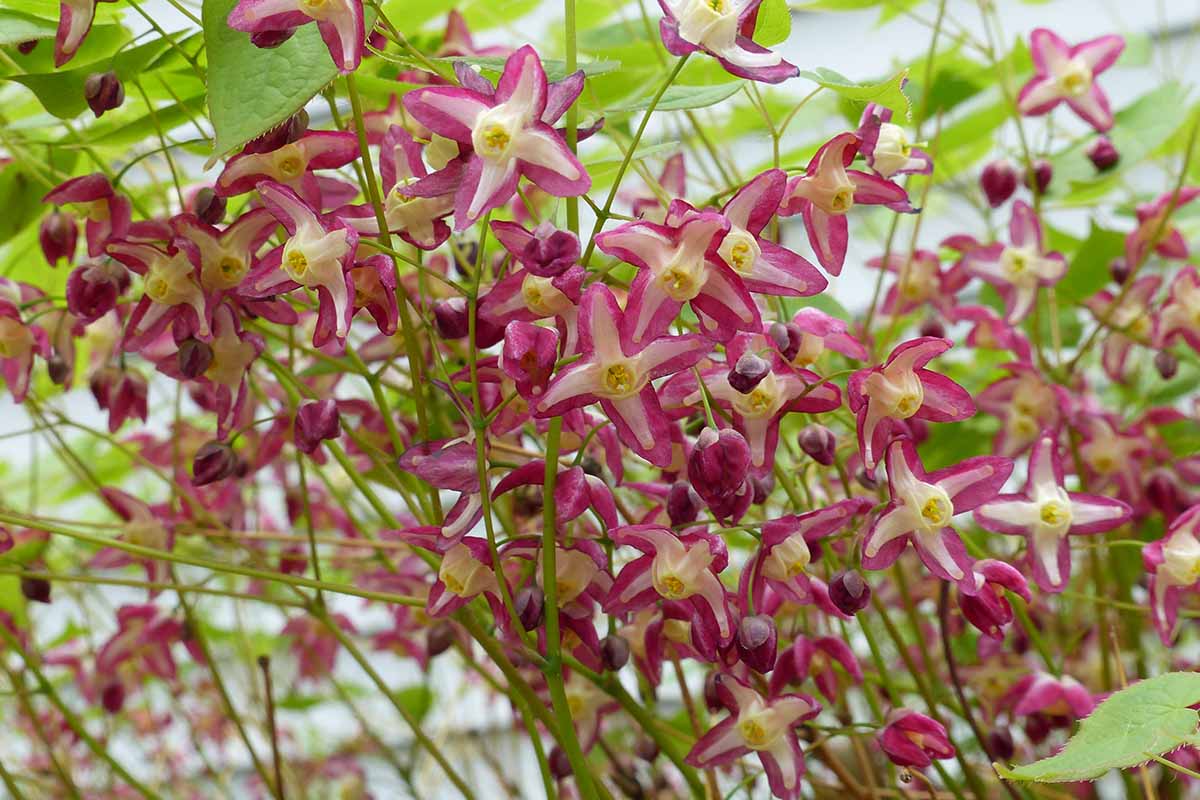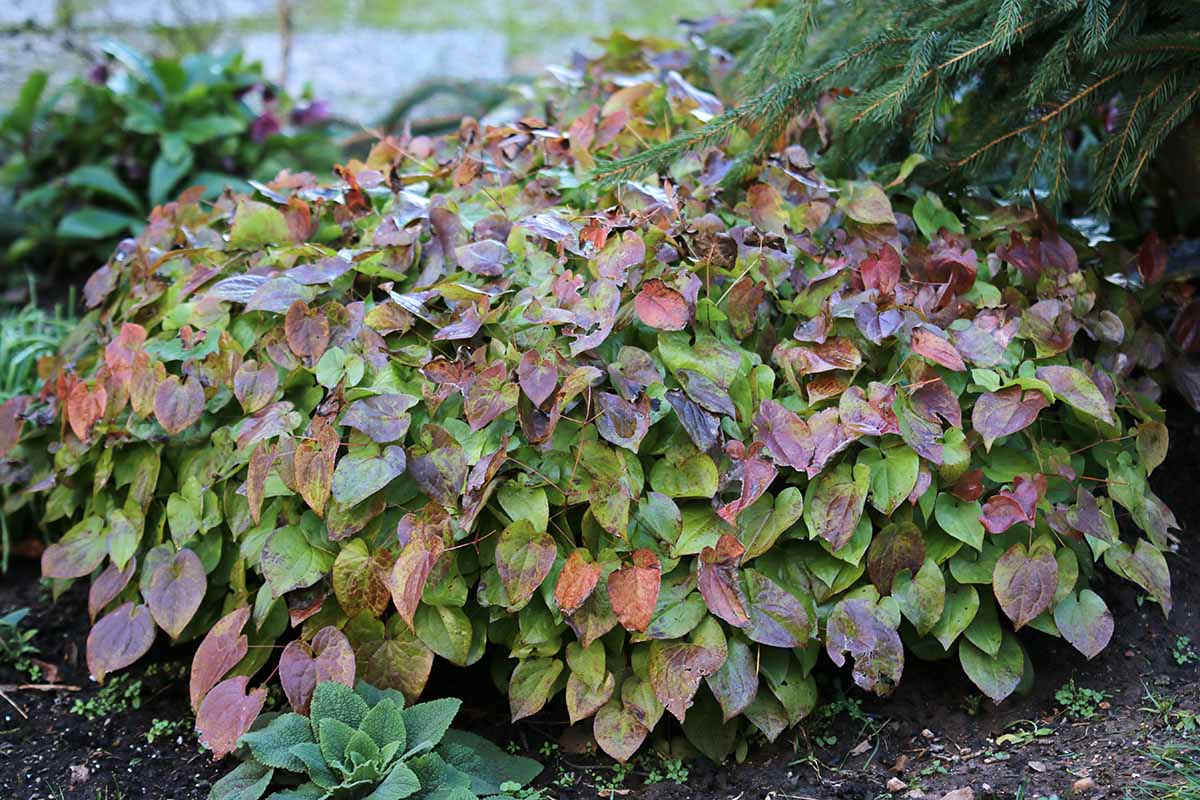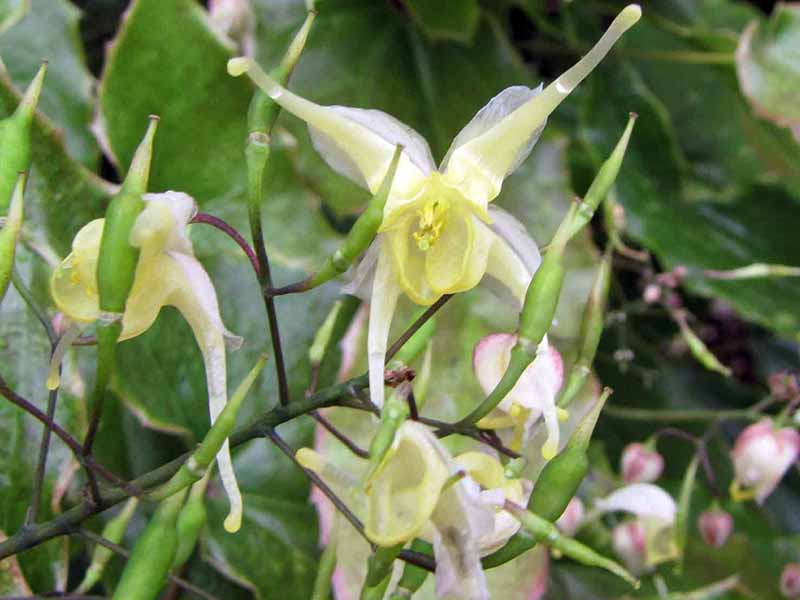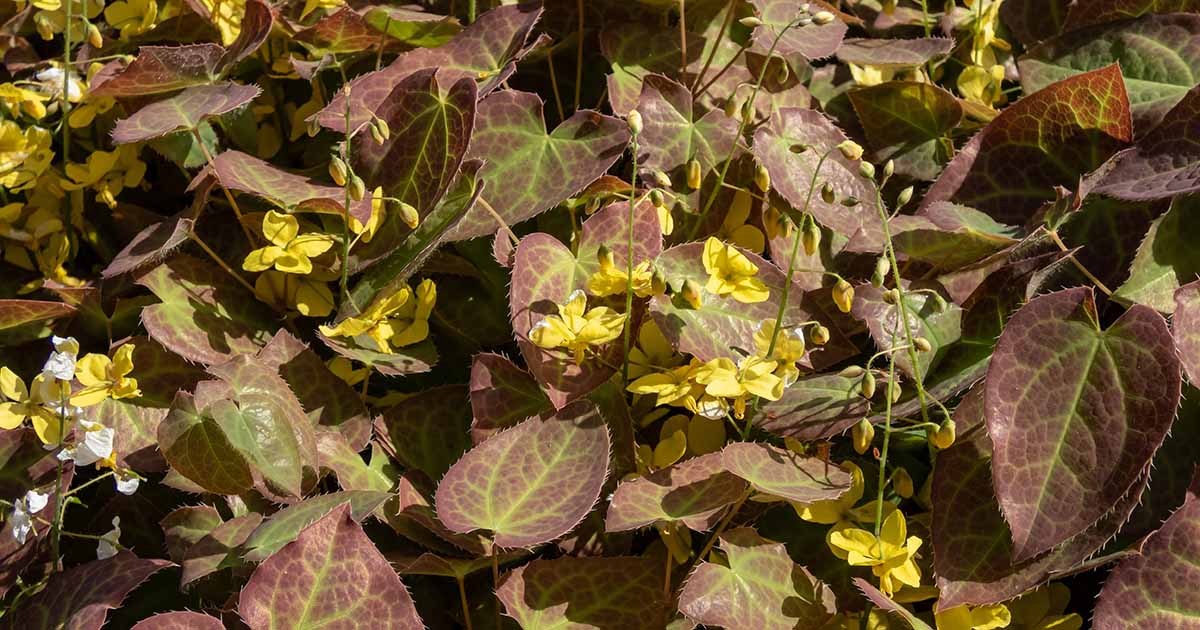Epimedium spp.
Just because something looks delicate doesn’t make it so. Barrenworts are proof of this.

We link to vendors to help you find relevant products. If you buy from one of our links, we may earn a commission.
Sure, there are several non-gardening examples that I could reference.
Exhibit A: a spider’s web (pound-for-pound, spider silk is stronger than steel).
Exhibit B: that one petite lady with a black belt at my Brazilian jiu-jitsu gym, who effortlessly ties everyone in knots during sparring sessions.
Species of Epimedium are similar in their deceptive toughness – the dainty flowers may be held high on skinny stems over lush foliage, but these plants are remarkably resistant to drought and heavy shade.
Plus, they don’t fall victim to the pests and pathogens that strike down less-resilient plants.
Barrenworts are also very adaptable, and they can easily grow in shallow soils. Plus, they’re positively gorgeous.
With this growing guide, you’ll learn everything you need to start growing these plants for yourself.
Here’s what we’ll go over:
What Is Barrenwort?
Also known as fairy wings or bishop’s hat, barrenworts are a group of herbaceous woodland perennials that belong to the Berberidaceae or barberry family.
The genus name Epimedium has its origin in the Greek epimedion, referring to an unknown Berberidaceae plant.
The common name “barrenwort” came from the belief that prolonged consumption of the roots causes infertility in women.

Hardy in USDA Zones 4 through 9, the Epimedium genus contains over 60 different recognized species. Most are native to eastern Asia – western China in particular – while the rest originate from the Mediterranean region.
Save for a handful of species, barrenwort leaves are compound, with each bearing three leathery leaflets. These are held on wiry stems.
Egg, heart, triangle, and/or elongated leaf shapes are exhibited in various species, as well as green-to-red leaf colors.
Depending on the species and the climate, barrenwort leaves may be evergreen, deciduous, or somewhere in between. In semi-evergreens, hues of red to maroon-purple are revealed in fall and winter.

Barrenwort blooms have four wispy petals, and these emerge anywhere from early spring to early summer.
The flowers sport yellow, pink, purple, red, or white colors – the outer stamens and inner petals are often two different shades of the same color. Each clump of four protruding stamens looks like a bishop’s hat, hence the nickname.
Pollinated blooms give way to seed pods resembling those of legumes, bursting with green seeds.
Similarly to bloodroot, each seed bears an attached elaiosome: a fatty, high-protein structure that encourages ants to take them back to their nest, thus disseminating the seeds far and wide.
Barrenworts spread via horizontal underground stems known as rhizomes.
Like most rhizomatous plants, barrenwort should be monitored to ensure that it doesn’t spread unchecked beyond its intended planting site.
But thanks to its slow growth rate, you won’t have to keep as much of an eye on it as you might with, say, a snake plant grown outdoors in the right conditions.
Cultivation and History
Besides its ornamental applications, barrenwort has been used historically by herbalists in China, Japan, and Korea as a treatment for impotence.
Yes, you read that correctly… flowers aren’t the only plants that might come in handy on date night.
According to legend, barrenwort’s potential as an aphrodisiac was discovered by a Chinese goat farmer.

After his goats consumed the plant’s foliage, the farmer noticed especially randy behavior among the herd. From this tall tale comes yet another nickname for Epimedium: yin yang huo, or horny goat weed.
Besides this rather stimulating potential side effect of barrenwort consumption, barrenwort has been used to treat joint pain and fatigue.
The plant has also been linked to improved cardiovascular, cerebrovascular, and immunomodulatory function, as well as anti-tumor and anti-aging effects.
Despite these purported benefits, I still wouldn’t recommend foraging it from your garden as an herbal substitute for Cialis or Viagra.
Be sure to always consult with a professional before embarking on any new herbal supplement regimens.
A Note of Caution
Before you consider ingesting horny goat weed, keep in mind that consumption may lead to severe breathing problems, affected heart function, and/or slowed blood clotting.
Additionally, ingesting barrenwort could potentially harm a developing fetus during pregnancy, and it may be responsible for other negative health effects.
After China established its “open door policy” in 1978, foreign botanists were permitted entry to the country, and many hybrids and species became introduced to the western world.
Today, barrenwort is beloved as a tough, adaptable planting for dry and/or shady spots in the garden.
Propagation
Propagating barrenwort is best done via seed, division, or transplanting.
From Seed
Seed propagation can be tricky, since these seeds need to be sown fresh as soon as they drop from their pods in order to have the best chance at germinating.
If you have mature plants available keep an eye on the developing seed pods.
Since cross-pollination between different nearby species of these plants is possible, you could end up with some interesting offspring as a result!

Prepare a planting area in partial shade with well-draining soil rich in organic matter.
After collecting the seeds, immediately sow them just below the surface of the soil. Space seeds a foot apart from each other, and keep the soil moist so that they don’t dry out.
The seeds will need to go through a period of cold stratification, remaining in the ground over the winter. Expect germination the following spring.
Continue to keep the soil around the seedlings moist as they grow, and they should flower in three to four years’ time!
Via Division
To ensure plant vigor, barrenworts should be divided once every three to four years. Division also serves as a pretty easy propagation method, and it can be done in early fall or early spring.

A day or two before you’re set to divide, water your barrenwort deeply. Make sure to remember where your plantings are, in case they don’t have foliage currently to indicate their location.
Come division time, dig up the plant and separate its root mass into two or more pieces, depending on the size and amount of divisions that you want.
You’ll probably need to use sharp and sterilized clippers on the tough woody crown to get you started, and then finish tearing apart the clump of rhizomes with your bare (or gloved) hands.
No need to aim for a certain amount of nodes or anything – it’s not a super precise process.
Once you have your divisions, they’re ready to go into the ground!
Via Transplanting
Whether it’s a potted specimen purchased from the nursery or a divided portion taken from an existing plant, transplanting barrenwort is pretty simple.

In your intended planting site, dig a hole about as deep and wide as the plant’s root system. A barrenwort’s roots don’t go down all that far, so the transplanting hole will be fairly shallow.
Lower the plant into the hole, backfill it with soil, and water it in. Transplants should become established in about a year. Be diligent about keeping the soil moist during this time.
How to Grow
Different species may not require identical growing conditions, but the following recommendations are a solid starting point for any barrenwort owner.
Climate and Exposure Needs
Collectively, plants in the Epimedium genus are hardy in Zones 4 to 9. The partial or dappled shade available in shade or woodland gardens makes for the perfect exposure.

If deep shade is all you have available, don’t worry – barrenwort can tolerate it.
Specimens grown in the more northern USDA Hardiness Zones within the acceptable range for these plants can handle greater amounts of sun, but they will need additional water to match their increased evapotranspiration rates.
Soil Needs
Perhaps surprisingly, ample fertility is essential for barrenworts to flourish. Additionally, the soil should drain well.
In general, barrenwort does well with a pH range of 5.0 to 7.0, but some species may tolerate pH values slightly outside of this range.
Water and Fertilizer Needs
Ideally, you should water whenever the soil surface feels dry to the touch.

Maintaining moist soil is optimal for these plants, but far from necessary.
Once established, barrenworts are quite drought-tolerant, but don’t use this as an excuse to treat these guys like succulents.
While scant irrigation may not kill them, it’ll further slow their already sluggish growth rate.
These plants are used to sitting in fertile growing sites, so amending their soil with a couple inches of compost each spring will provide the necessary organic material.
Growing Tips
- Partial shade is ideal, and full shade is tolerable.
- Make sure the soil is well-draining.
- Maintain soil moisture by watering whenever the surface dries out.
Pruning and Maintenance
After the flowers bloom, feel free to deadhead them if you don’t intend to harvest seed. Don’t forget to divide your barrenworts every three to four years!

Every year in mid- to late winter, deciduous barrenwort leaves should be cut down to the ground, while evergreen and semi-evergreen Epimedium foliage can be left alone.
This makes the emerging flowers more visible come spring and summer, and removes any insect-chewed or weather-beaten foliage.
As a way to prevent weed growth, conserve moisture, and increase the humus content of soil even more, add a couple inches of shredded leaf mulch to the soil surrounding your barrenwort each spring.
Species to Select
“Paralysis by analysis” can easily set in when you’re deciding on what kind of Epimedium to plant. These three species are fantastic gateway barrenworts to choose from.
Acuminatum
Also known as the acuminate barrenwort, E. acuminatum has narrow, dark green foliage with gently-pointed tips, heart-shaped bases, and spiny leaf margins.

Spidery, purple and white blooms hang down in clumps from spindly flower stems, and these look a lot like the grabber claws on an arcade game.
Native to the alpine woodlands of central and western China, this species forms attractive mounds of foliage in the landscape, with compound inflorescences that poke out from the leaves and stand tall. A definite beaut.
Grandiflorum
You’ll really “heart” the heart-shaped foliage of E. grandiflorum, which has spiny leaf margins and a medium green hue.

Native to Korea, Japan, and northeast China, this plant also goes by the name large-flowered barrenwort, and produces blooms with white petals purple to rose pink sepals, and lengthy nectar spurs.
When these flowers rise above the heart-shaped leaves with their rosy Valentine’s Day color, the mood is well and truly set… especially when you consider the plant’s known properties as an aphrodisiac.

‘Lilafee’
For a beautiful E. grandiflorum cultivar with blooms that lean to the purple side of the spectrum, behold ‘Lilafee,’ available from Nature Hills Nursery in #1 containers.
Wushanense
First described in 1975 by Chinese botanist T. S. Ying, E. wushanense – i.e. Wushan fairy wings – is one of the biggest barrenwort species, flaunting mounds of leathery, dark green, spiny, and lance-shaped foliage that can reach two feet in height.

The leaves of E. wushanense definitely steal the show, but the flowers are nothing to sneeze at, either (unless you have seasonal allergies, perhaps).
Clumps of cream-colored flowers bloom on erect stems that poke through the mound of evergreen foliage. Dark green leaves and off-white blooms are truly a winning combo!
Managing Pests and Disease
Along with drought and shade, barrenwort is resistant to a fair amount of pests and health problems that may plague other plants, such as deer, rabbits, insects, and diseases.
Well… most insects and diseases, anyway.
Pests
Insects can often vector pathogens as they feed from plants, so preventing and managing infestations will definitely help you out on the disease front.
Slugs
These terrestrial, shell-less mollusks will leave irregularly-shaped, smooth-edged holes in leaves. Besides reducing aesthetics, the diminished foliage impacts photosynthesis, which stunts growth.
Effective slug management starts with prevention: eliminate potential shady spots where slugs can hide.
This may be tough in a shade garden or wooded area, but weeds, stones, and plant debris can be removed as needed.
Have an infestation on your hands? Come nighttime, use a flashlight to locate the glistening slime trails that can be followed back to a slug’s location.
Once you find them, pick them off by hand and seal them in plastic bags for disposal.
Setting out traps can serve as a more passive way to catch slugs.

Slug and Snail Traps
This three-pack of ABS plastic traps from Gardener’s Supply is a fantastic set of slug snares. Simply pour in some beer, set the traps, and wait for the slugs to drown in suds.
Vine Weevils
Members of a group of beetle families within the Curculionoidea superfamily, vine weevils can feed on barrenwort at all stages of their life cycle.
The adults are black with dirty-yellow markings on the wing cases, and the legless, plump, and C-shaped grubs have light brown heads and white bodies.

The adults munch irregular notches from the leaf margins, while the grubs consume the roots. The foliar damage is pretty much a cosmetic issue, while root consumption can lead to plant wilting and death.
After the sun goes down, the adults can be tracked down with the assistance of a flashlight and removed by hand.
Sticky traps placed nearby can trap vine weevils and act as an additional infestation indicator, allowing gardeners to monitor pest activity.
Birds, amphibians, shrews, and other predators consume vine weevil adults and grubs, so be sure to foster plenty of biodiversity in the garden!
To specifically target vine weevil grubs, certain species of beneficial nematodes such as Heterorhabditis bacteriophora are quite effective when applied to the soil.

NemaSeek Beneficial Nematodes
If microscopic biological warfare interests you, then you should give this these beneficial H. bacteriophora nematodes from Arbico Organics a try.
Disease
A general prescription for disease prevention includes using pathogen-free plants, clean soil, and sanitized gardening tools.
Mosaic Virus
Affecting more than 150 different kinds of plants, mosaic viruses are easily recognizable, creating a “mosaic” of white, yellow, and/or discolored green spots and streaks on the foliage of infected plants. Growth is often stunted and leaves become distorted.

Because there is no known cure for mosaic virus, any infected plants should be removed and destroyed.
Since certain weeds can host the disease, it’s important to keep on top of your weeding practices.
Best Uses
Aside from its medicinal uses, barrenwort flaunts a stunning appearance. These species look their best when used as ground cover in a shade or woodland garden.

The shallowness of their root systems makes them quite adept at growing between the large roots of trees, as well as among other plantings as a sort of “living mulch.”
Additionally, the fibrous roots make the plant rather effective at controlling soil erosion.
Quick Reference Growing Guide
| Plant Type: | Herbaceous perennial | Flower/Foliage Color: | White, yellow, pink, purple/green, red |
| Native to: | Asia, Mediterranean region | Water Needs: | Moderate |
| Hardiness (USDA Zones): | 5-9 | Maintenance: | Low |
| Bloom Time: | Early spring to early summer | Tolerance: | Deer, dry soil, heavy shade, rabbits, rocky soil |
| Exposure: | Partial shade | Soil Type: | Fertile |
| Time to Maturity: | 3-4 years | Soil pH: | 5.0-7.0 |
| Spacing: | 12 inches | Soil Drainage: | Well-draining |
| Planting Depth: | Just below surface (seeds), depth of root system (transplants) | Attracts: | Bees, other pollinating insects |
| Height: | 6-24 inches | Uses: | Ground cover, medicinal herb garden, shade garden, woodland garden |
| Spread: | 12-36 inches | Family: | Berberidaceae |
| Growth Rate: | Slow | Genus: | Epimedium |
| Common Pests and Diseases: | Slugs, vine weevils; mosaic virus | Species: | Acuminatum, grandiflorum, wushanense |
Barrenworts: Perfect for Worrywarts
For the sort of gardener that freaks out at the slightest bit of wilting, barrenwort is the perfect low-maintenance plant.

With durability against drought, heavy shade, and most health issues, a barrenwort merits very little concern, leaving you free to direct your worries toward other, more fragile plantings.
Once you start growing these guys, you’ll see for yourself how easy and laid-back barrenwort care can be. Go ahead and give it a try!
To any readers with questions or remarks, the comments section is your oyster.
And for more information about growing shade-loving plants in your garden, check out these guides next:











